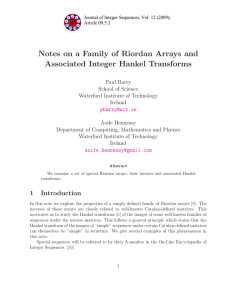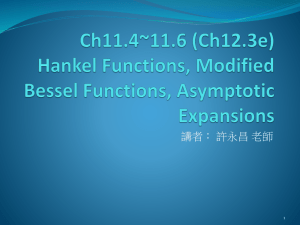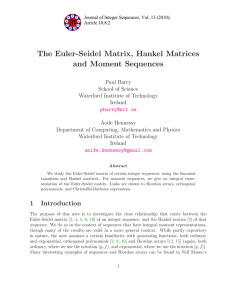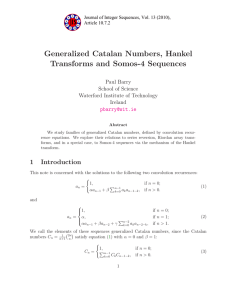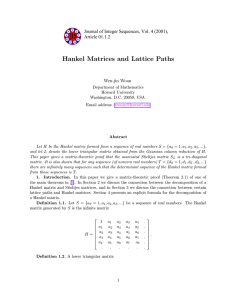The Hankel Transform and Some of its Properties Article 01.1.5
advertisement
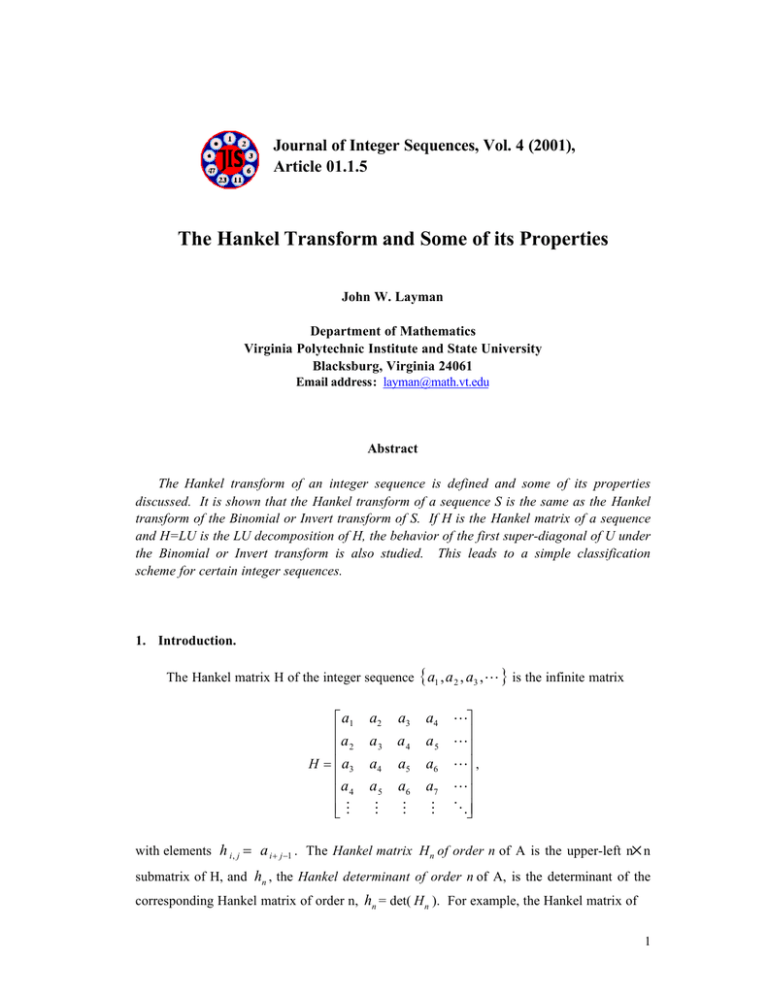
Journal of Integer Sequences, Vol. 4 (2001),
Article 01.1.5
The Hankel Transform and Some of its Properties
John W. Layman
Department of Mathematics
Virginia Polytechnic Institute and State University
Blacksburg, Virginia 24061
Email address: layman@math.vt.edu
Abstract
The Hankel transform of an integer sequence is defined and some of its properties
discussed. It is shown that the Hankel transform of a sequence S is the same as the Hankel
transform of the Binomial or Invert transform of S. If H is the Hankel matrix of a sequence
and H=LU is the LU decomposition of H, the behavior of the first super-diagonal of U under
the Binomial or Invert transform is also studied. This leads to a simple classification
scheme for certain integer sequences.
1. Introduction.
The Hankel matrix H of the integer sequence
a1
a
2
H = a3
a
4
M
a2
a3
a3 a4
a4 a5
a 5 a6
M
M
{ a1 , a 2 , a3 , L } is the infinite matrix
a4 L
a 5 L
a6 L ,
a7 L
M O
with elements h i , j = a i + j −1 . The Hankel matrix H n of order n of A is the upper-left n5n
submatrix of H, and hn , the Hankel determinant of order n of A, is the determinant of the
corresponding Hankel matrix of order n, hn = det( H n ). For example, the Hankel matrix of
1
order 4 of the Fibonacci sequence 1,1,2,3,5,… , is
1
1
H4 =
2
3
1
2
3
5
2 3
3 5
,
5 8
8 13
with 4th order Hankel determinant h4 = 0. Hankel matrices of integer sequences and their
determinants have been studied in several recent papers by Ehrenborg [1] and Peart and
Woan [2].
Given an integer sequence A = { a1 , a2 , a 3 , L }, the sequence
{hn } = { h1 , h2 , h3 , L }
of Hankel determinants of A is called the Hankel transform of A, a term first introduced by
the author in sequence A055878 of the On-Line Encyclopedia of Integer Sequences (EIS)[5].
For example, the Hankel matrix of order 4 of the sequence of Catalan numbers
{1, 1, 2, 5, 14, 42, 132, L } (sequence A000108 in the EIS) is
5
1 1 2
1 2 5 14
,
H4 =
2 5 14 42
5 14 42 132
and the determinants of orders 1 through 4 give the Hankel transform {1, 1, 1, 1, … }.
The Hankel transform can easily be shown to be many-to-one, illustrated by the fact
that a search of the EIS finds approximately twenty sequences besides A000108 that have the
Hankel transform {1, 1, 1, 1, … }.
The author and Michael Somos [6], working
n
independently, found ten sequences in the EIS whose Hankel transform is {
∏ (i!)
2
}
i =0
(A055209 ), which was shown theoretically by Radoux [3] to be the Hankel transform of the
derangement, or rencontres, numbers (A000166 ). Other examples of groups of sequences in
the EIS all of which have the same Hankel transform may be found in the comments to
sequences A000079 and A000178.
2. Invariance of the Hankel Transform.
Further computational investigation reveals numerous instances in which one member
of a pair of sequences with the same Hankel transform is the Binomial or Invert transform of
the other. Some examples are provided by A000166 and its Binomial transform A000142 ,
2
both of which have the Hankel transform A055209, and by A005043 and its Invert transform
A001006 , both of which have {1, 1, 1, 1, …} for their Hankel transform. In the following it
is shown that this invariance of the Hankel transform under applications of the Binomial or
Invert transform holds in general. The definitions of the Binomial and Invert transforms
may be found on the EIS web site [5].
Theorem 1. Let A be an integer sequence and B its Binomial transform. Then A and B have
the same Hankel transform.
Proof. Let A = { a1 , a2 , a 3 , L } and B = {b1 , b2 , b3 , L }, and define H* to be the matrix
H* = RHC, where the elements of R, H, and C are given by
0, if i < j ,
ri , j = i − 1
,
j − 1, if i ≥ j
hk ,m = a k +m −1 , and ci , j
0, if i > j,
= j − 1
,
i − 1 , if i ≤ j
i
and denotes the usual binomial coefficient. Then the elements of H* are
j
h *i , j =
i
j
i − 1
∑ ∑ k − 1 a
k + m −1
k =1 m =1
j −1
,
m − 1
which, by making slight changes of variables, gives
h *i , j =
i −1
j −1
i − 1 j − 1
a k +m−1 .
m
∑ ∑ k
k =0 m=0
By the well-known Vandermonde convolution formula [4] and another slight change of
variable, this reduces to
h *i , j =
i + j −1
∑
s =1
i + j − 2
a s ,
s−1
which, by the definition of the Binomial transform (see [5]), is bi + j −1 , thus showing that H*
is the Hankel matrix of sequence B. Thus the terms of the Hankel transforms of the
sequences A and B are det( H n ) and det( Rn H nC n ), respectively, where Rn , H n , and C n
are the upper-left submatrices of order n of H, R, and C, respectively. But Rn and C n are
3
both triangular with all 1's on the main diagonal, thus det( Rn ) and det( C n ) are both 1, and
therefore det( H n ) = det( Rn H nC n ), completing the proof.
z
Theorem 2. Let A be an integer sequence and B its Invert transform. Then A and B have
the same Hankel transform.
Proof. Let A = { a1 , a2 , a 3 , L } and B = {b1 , b2 , b3 , L }, and define H* to be the matrix
H*=RHC, where the elements of R, H, and C are given by
0, if j < m ,
hk ,m = a k +m−1 , and cm , j =
,
≥
b
,
if
j
m
−
j
m
0, if k > i ,
ri ,k =
,
bi − k , if k ≤ i
where b0 is defined to be 1. Then the (i, j-1)-element of H* given by
j −1
i
∑∑b
h *i , j −1 =
i −k
k =1 m =1
j −1
i
j −1
∑∑b
=
i −k
k = 2 m =1
a k +m−1 b j −m−1
ak +m−1 b j −m−1 + bi −1 ∑ a m b j −m−1
j −1
i −1
∑∑b
=
i −1− k
k =1 m =1
i −1
j
∑∑b
=
i −1− k
k =1 m = 2
i −1
ak +m b j −m−1
j−2
+ bi −1 ∑ a m b j −m−1 + a j −1
m=1
a k +m−1 b j −m + bi −1b j −1
i −1
j
∑∑
=
m =1
bi −1−k ak +m−1 b j −m + b j −1 ∑ bi −1−k ak + bi −1b j −1
k =1 m =1
k =1
= h *i −1, j ,
showing that elements of H* are constant along anti-diagonals. But, clearly,
h *1, j =
j
1
∑∑b
k =1 m =1
1− k
ak +m−1 b j −m
j
= b0 ∑ am b j − m
m =1
= bj ,
4
the last step following from the definition of the Invert transform (see [5]), which shows that
h *i , j = bi + j −1 or, in other words, that H* is the Hankel matrix of B. Since L and R are
triangular with diagonals consisting of all 1's, this shows that the Hankel determinants of B
are the same as those for A, and thus A and B have the same Hankel transform.
z
3. The LU Decomposition and the First Super-Diagonal.
If the LU-decomposition of the Hankel matrix of an integer sequence A is H = LU,
then the main diagonal of U clearly determines the Hankel transform of the sequence, and
vice versa. By Theorem 1, if H* = L*U* is the LU-decomposition of the Hankel matrix H*
of the Binomial or Invert transform of A, then the main diagonals of U and U* are identical.
Thus the main diagonal of U is not sufficient to determine the sequence A, a point already
noted. It is easy to see, however, that the main diagonal of U and the first superdiagonal,
taken together, do determine A. It suffices to note, in proof, that H n , the Hankel matrix of
order n, consists of the first 2n-1 terms a1 , a2 , a 3 , L of A and that the main diagonal and
first superdiagonal of U n contain 2n-1 elements whose values are linear combinations of the
a's. Thus, U1,1 determines a1 , U1,2 and U 2 , 2 determine a2 and a 3 , and, by recursion,
U n−1,n and U n , n determine a2 n−2 and a 2n −1 .
Because of the result just stated, it is of some interest to know how the first
superdiagonal of U* is related to the first superdiagonal of U, where H=LU and H*=L*U*.
The following two theorems give this relationship when A* is the Binomial transform or
Invert transform of A.
Theorem 3. Let H and H* be the Hankel matrices of the integer sequence A and its
Binomial transform A*, respectively, and let H=LU and H*=L*U* be their LUdecompositions.
Then the first super-diagonals of U and U* are related by
*
U i , i +1 = U i ,i +1 + iU i ,i .
Proof. We have H = LU and, by the proof of the previous theorem, H* = RHC = RLUC,
where the matrices R and C are as defined in that theorem. Thus U* = UC or, in terms of
elements,
j
j − 1
U i*, j = ∑ U i , k k − 1 ,
k =1
which, since U i , k is upper triangular, can be written
j
j − 1
U i*, j = ∑ U i , k k − 1 .
k =i
5
The elements on the first super-diagonal are therefore given by
i
i
U i*, i +1 = U i , i i − 1 + Ui , i +1 i ,
which reduces immediately to
U i*, i +1 = U i ,i +1 + iU i ,i ,
z
as was to be proved.
A special case, which is of some interest because of a fairly large number of examples
found in the EIS, follows immediately and is stated in the following corollary.
Corollary 1. Let A be an integer sequence with Hankel transform {1, 1, 1, 1, 1, …} and let
H and H* be the Hankel matrices of A and its Binomial transform A*, respectively. Then, if
H=LU and H*=L*U* are the LU-decompositions of H and H*, the first superdiagonals of U
and U* are related by U i*, i +1 = U i , i + i .
The analogous results for the Hankel matrix of the Invert transform of a sequence
follow.
Theorem 4. Let A be an integer sequence, with Hankel matrix H, and let B be the Invert
transform of A, with Hankel transform H*. Let H=LU be the LU-decomposition of H and
H*=L*U* the LU-decomposition of H*. Then the elements of the first superdiagonals of U
and U* are related by u*i , i + 1 = ui , i +1 + a1ui , i .
Proof. Let the matrices R and C be as in the proof of Theorem 3. Then H* = L*U* = RHC
=RLUC, from which it follows that U* = UC. Thus we have, in general,
u *i , j =
j
∑u
m=i
i, m
b j −m ,
and, in particular,
u*i , i +1 =
i +1
∑u
m =i
i, m
bi +1−m
= u i , i b1 + u i ,i +1 b0
= ui ,i +1 + a1 ui , i ,
completing the proof.
z
Again, because of the large number of sequences in the EIS with Hankel transform {1,
1, 1, 1, 1, …}, we state the following corollary.
6
Corollary 2. Let A be an integer sequence with Hankel transform {1, 1, 1, 1, 1, …} and let
H and H* be the Hankel matrices of A and its Invert transform A*, respectively. Then, if
H=LU and H*=L*U* are the LU-decompositions of H and H*, the first superdiagonals of U
and U* are related by U i*, i +1 = U i , i + 1 .
4. Sequences with Hankel Transform {1, 1, 1, 1, 1, …}.
A search of the EIS database found almost twenty sequences with Hankel transform {1,
1, 1, 1, 1, …}, of which seventeen are related through the Binomial and Invert transforms.
In a few cases an initial term or two must be added or deleted. It is rather surprising that all
of these sequences exhibit a linear polynomial behavior of the first super-diagonal when
reduced to upper triangular form. Table 1 below illustrates the relationships among these 17
sequences. Each sequence in the table is the Binomial transform of the sequence in the
adjacent column to its left and the Invert transform of the sequence in the adjacent row just
above the given entry. The linear polynomial written just below the EIS sequence number
gives the elements of the first super-diagonal of U in the LU decomposition H=LU, where H
is the Hankel matrix of the sequence. The parameter i is the row index of U. The operator
(E) denotes the shift operator and is used here to denote the deletion of the first term of the
sequence. Added initial terms are shown in braces.
Note that, because of Corollaries 1 and 2 governing the behavior of the elements of the
first superdiagonal under the action of the Binomial or Invert transforms, the constant terms
increase by 1 for each row change from top to bottom and the first degree coefficient
increases by 1 for each column change from left to right. In one case, in the bottom row, in
which the first superdiagonal is described by the polynomial i+2, the sequence, which is the
Binomial transform of A054341 and the Invert transform of (E) A005773 and whose initial
terms are {1,3,10,34,117, …}, was not found to be listed in the EIS. It has since been listed,
and now appears in the encyclopedia as sequence A059738 .
Table 1.
{1,0} U A000957
2i - 2
A033321
A033543
3i - 2
4i - 2
A005043
A000108
A007317
i-1
2i - 1
(E)A000108
2i
A002212
3i
4i
A001700
A026378
A005573
2i + 1
3i + 1
4i + 1
A001006
1
I
(E)A005773
i+1
A054341
{1,3,10,34,117, …}
A049027
2
i+2
2i + 2
A001405
3i - 1
A005572
7
In order to illustrate the significance of this table, we look at A000108 (the Catalan
numbers, with many combinatorial interpretations, one of which is the number of ways to
insert n pairs of parentheses in a word of n letters) in row 2 and column 3 of the table. The
sequence is {1, 1, 2, 5, 14, 42, 132, 429, 1430,…}, with Hankel matrix
2
5
14 L
1 1
1 2
5
14
42 L
2 5 14 42 132 L
5 14 42 132 429 L ,
14 42 132 429 1430 L
M
M
M
M
O
M
which row-reduces to the upper-triangular form
1
0
U = 0
0
0
1
1
0
0
0
2
3
1
0
0
5 14
9 28
5 24
1 7
0 1
which clearly exhibits the Hankel transform of {1, 1, 1, 1, 1, …} and the 2i-1 polynomial
behavior of the first super-diagonal {1, 3, 5, 7, …}, as indicated in the table. If we now take
the Binomial transform of A000108 , we get {1, 2, 5, 15, 51, 188, 731, …} = A007317 , with
Hankel matrix
2
5
15
51
1
2
5
15
51
188
5 15 51 188
731 ,
15 51 188 731 2950
51 188 731 2950 12235
which, in turn reduces to the upper-triangular form
1
0
U = 0
0
0
2
1
0
0
0
5 15 51
5 21 86
1 8 46 ,
0 1 11
0 0 1
8
showing the Hankel transform {1, 1, 1, 1, 1, …} and the first super-diagonal {2, 5, 8, 11, …}
= {3i-1}, again in agreement with the table.
If we now return to A000108 and take its Invert transform, we get (E) A000108 = {1, 2, 5,
14, 42, 132, 429, 1430, 4862, …}, that is, A000108 with the first term deleted. The Hankel
matrix of this sequence row-reduces to
1
0
U = 0
0
0
2
1
0
0
0
5 14 42
4 14 48
1 6 27 ,
0 1 8
0 0 1
again revealing the Hankel transform {1, 1, 1, 1, 1, …} and the polynomial behavior of 2i
for the first super-diagonal, {2, 4, 6, 8, …}, in agreement with row 3, column 3 of the table.
Three other sequences have been found in the EIS which have the Hankel transform {1,
1, 1, 1, 1, …} but do not have a linear polynomial behavior of the first super-diagonal when
reduced to upper-triangular form. These are A054391 , A054393 , and A055879, with first
super-diagonals {1, 3, 4, 5, 6, …}, {1, 3, 5, 6, 7, …}, and {1, 2, 2, 3, 3, 4, 4, …},
respectively.
5. Other Families of Sequences.
Several other families of sequences, each member of which has the same Hankel
transform sequence, have been found in the EIS, but the relationships among the members of
the family via the Binomial and Invert transforms is much less complete than that indicated
in Table 1 for the case of Hankel transform {1, 1, 1, 1, 1, …}.
Seven sequences have been found with Hankel transform {1, 2, 4, 8, 16, …}: A000984,
A002426 , A026375 , A026569 , A026585, and A026671. Four of these are related by the
Binomial and Invert transforms, as shown in the following Table 2 in which each sequence
listed is the Binomial transform of the sequence just to the left and the Invert transform of
the sequence just above.
Table 2.
A002426
A000984
A026671
A026375
Seven sequences were found with Hankel transform {1, 1, 2, 12, 288, …}: A000085 ,
A000110 , A000296 , A005425 , A005493, A005494, and A045379 . These are all related to at
9
least one other by the Binomial transform, as shown in Table 3, in which each sequence is
the Binomial transform of the sequence just to its left. No Invert transform relations hold
among adjacent rows.
Table 3.
A000296
A000110
(E)A000110
A000085
A005493
A005494
A045379
A005425
Several of the sequences listed above, with Hankel transform {1, 1, 2, 12, 288, …}, as
well as some of those below, with Hankel transform {1, 1, 4, 144, 82944, …}, were
discussed by Ehrenborg in [1].
Nine sequences were found with Hankel transform {1, 1, 4, 144, 82944, …}: A000142,
A000166 , A000522 , A003701 , A010483, A010842, A052186, A053486 , and A053487 . Seven of
these are related to at least one other by the Binomial or Invert transform. Table 4 shows
these relationships, following the same format as used for Table 1.
Table 4.
A000166
A052186
A000142
A000522
A010842
A053486
A053487
6. Concluding Remarks.
Among questions raised by this investigation into properties of the Hankel transform we
mention two which seem to be deserving of further study.
First, is there a combinatorial significance to the fact that essentially all studied
sequences listed in the EIS [5] that have the Hankel transform {1, 1, 1, 1,…} and are related
by the Binomial or Invert transform, have a first super-diagonal which, when reduced to
upper-diagonal form, is linear in the row index with small coefficients, with constant terms
ranging from -2 to 2 and first degree terms ranging from 0 to 4, as shown in Table 1?
Second, are there other interesting transforms, T, of an integer sequence S, in addition
to the Binomial and Invert transforms studied in this paper, with the property that the Hankel
transform of S is the same as the Hankel transform of the T transform of S?
References
1. Richard Ehrenborg, The Hankel Determinant of Exponential Polynomials, American
Mathematical Monthly, 107(2000)557-560.
10
2. Paul Peart and Wen-Jin Woan, Generating Functions via Hankel and Stieltjes Matrices,
Journal of Integer Sequences 3(2000)00.2.1 (13 p.)
3. C. Radoux, Déterminant de Hankel construit sur des polynomes liés aux nombres de
dérangements, European Journal of Combinatorics 12(1991)327-329
4. J. Riordan, Combinatorial Identities, Robert E. Krieger Publishing Co., N.Y., 1979 (p.
8).
5. N.
J.
A.
Sloane,
The
On-Line
http://www.research.att.com/~njas/sequences/ .
Encyclopedia
of
Integer
Sequences,
6. Michael Somos, See Sequence A055209 of the EIS (reference 5 above).
(Concerned with sequences A000079, A000085, A000108, A000110, A000142, A000166, A000178,
A000296, A000522, A000957, A000984, A001006, A001405, A001700, A002212, A002426,
A003701, A005043, A005425, A005493, A005494, A005572, A005773, A007317, A010483,
A010842, A026375, A026378, A026569, A026585, A026671, A033321, A033543, A045379,
A049027, A052186, A053486, A053487, A054341, A054391, A054393, A055209, A055878,
A055879, A059738.)
Received May 3, 2001. Published in Journal of Integer Sequences, June 8, 2001.
Return to Journal of Integer Sequences home page.
11
